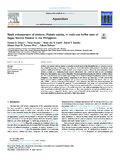Stock enhancement of abalone, Haliotis asinina, in multi-use buffer zone of Sagay Marine Reserve in the Philippines
Share
抄録
Donkey's ear abalone (Haliotis asinina) is a gourmet seafood export of the Philippines but its wild stock is at risk due to high fishing pressure. This paper aims to show evidences that abalone seeds produced in hatcheries can be used to rehabilitate its fisheries in multi-use buffer zones of marine reserves. This study released hatchery-reared abalone juveniles in a community-based resource enhancement site located in multi-use reef surrounding Molocaboc. This island is populated by fisherfolks who participated in protecting the 4000 m2 coralline release site. Molocaboc Reef comprise the buffer zone of Sagay Marine Reserve in Negros Occidental province in central Philippines. Data obtained during monthly monitoring of the release site from 2011 to 2016 showed that hatchery-reared abalone established together with its wild counterparts. Baseline wild abalone catch per unit effort (CPUE = 3 divers 1 h fishing) is 0.005/100 m2 in 2011. Mean monthly CPUE after release increased to 53 hatchery-reared and wild individuals combined. The mean shell length, body weight and body mass index of the hatchery-reared individuals (6.4 cm, 70.9 g, 10.5 g/cm) is not significantly different from those of the recovered wild stocks (6.9 cm, 85.0 g, 12.0 g/cm). The stocks recovered in the midst of undisrupted fishing activities in areas immediately outside and beyond the release site. Thus, mass production of seeds of overfished species is advised to repopulate degraded fisheries, improve catch of fisherfolks living within buffer areas of marine reserves and contribute to production and trade of high-value species.
Suggested Citation
Salayo, N. D., Azuma, T., Castel, R. J. G., Barrido, R. T., Tormon-West, D. H. M., & Shibuno, T. (2020). Stock enhancement of abalone, Haliotis asinina, in multi-use buffer zone of Sagay Marine Reserve in the Philippines. Aquaculture , 523, 735138. https://doi.org/10.1016/j.aquaculture.2020.735138
Collections
- AQD Journal Articles [1249]

